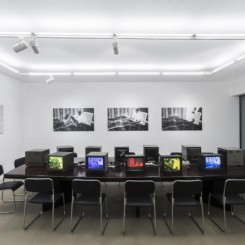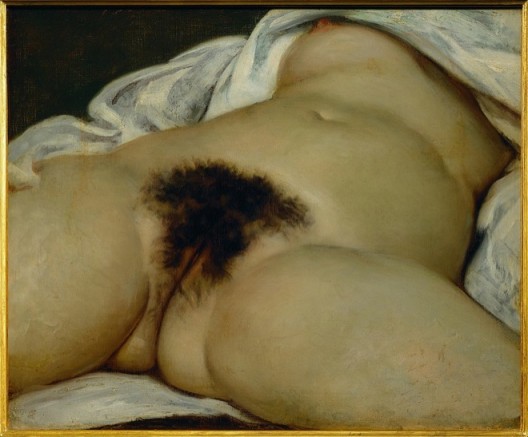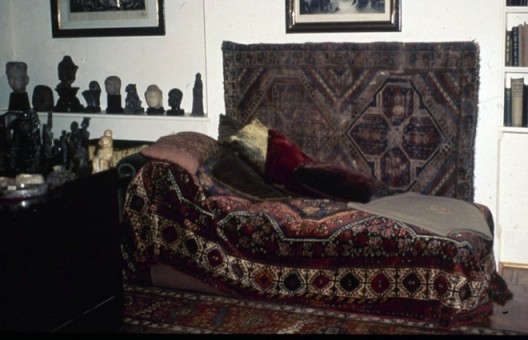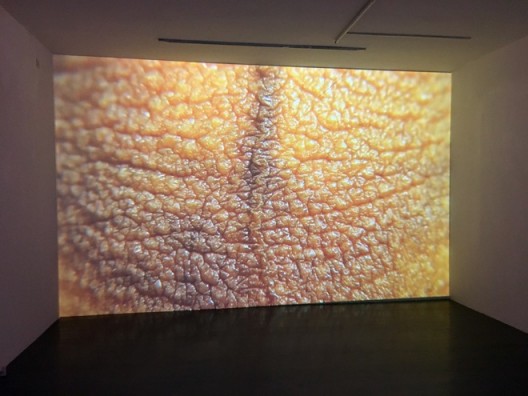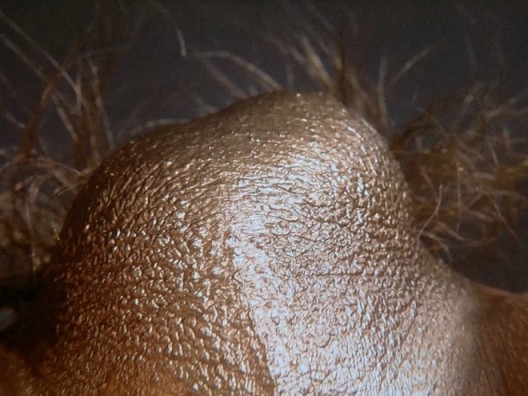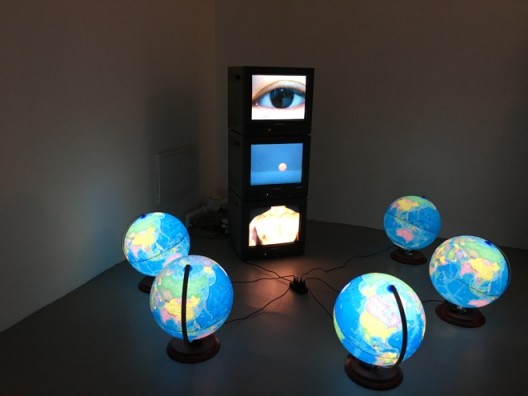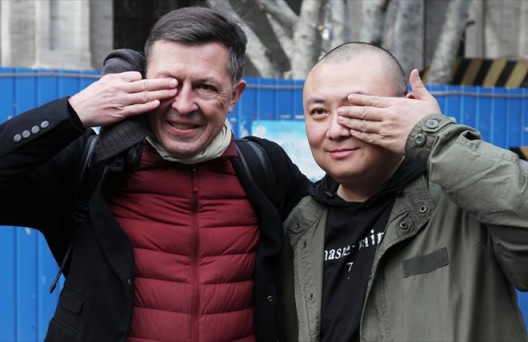Desire and the visual have forever been intertwined. You cannot desire what you already have, so the object of desire is something spatially removed from oneself – a distance that can only be bridged by our sense of vision. All other senses, touch, smell, taste and even sound require a much closer proximity than sight.
Sight and beauty also are inextricably linked and have a pre-cognitive effect on both the subject and object of sight. Desire happens before recognition and the term “falling in love” might be an accurate description of an involuntary stumble that happens when you least expect it.
But when it happens, it might or might not be reciprocal. A fact that is also interesting, when you want to further understand the dynamics of visual desire.
Fully aware that there are all the colors of the rainbow and also all shades of grey – let´s just stick to the stereotype for simplicity´s sake and say: Boy meets girl. – What actually happens? He sees her and falls in love. Is it her beauty that triggers this event, or does he project his desire onto her? In that visual act… is the eye receiving beauty or does it send a message. It needs to be reciprocal to initiate a love relationship. If that doesn´t happen, does he who sees, project to no response? Is beauty an agent that turns against its bearer at times? Would she, who is looked at (keep in mind that she could also be a he), feel offended by being looked at?!
Is the eye a camera or a projector?! – In any case, the gaze always precedes the touch and it is probably the human condition that sight, when things go well, first facilitates proximity and then ultimately intimacy.
However culturally there are stark differences as to what kind of visual regime is socially desirable or acceptable and what is not. This of course is also contingent on historical developments within cultures. Courbet´s “Le origine du monde”, depicting a hairy vulva from close proximity and, more shockingly, rendered at eye level, is such an image. When the artist first painted it, it could by no means be shown in public and today it is one of the most circulated images by the artist. Art – and its visual regime – is indicative of any society´s regard of desire. And let´s face it, with desire comes temptation and ultimately conflict. Maybe this is why humans invented culture in the first place. There are large parts of the world that veil beauty in order to defuse it. Other parts have been trying to convince its people to look at inner beauty before the outer and Asian tradition has it to take one´s eyes off of all worldly things altogether.
What do we learn from this? – Desire, beauty and the visual are absolutely potent and potentially disruptive forces, always to be reckoned with. We also learn: With image machines connecting people globally, culturally coded visual regimes can no longer contain those forces. Everybody can see everything, but not everybody might see the same, seeing the same thing.
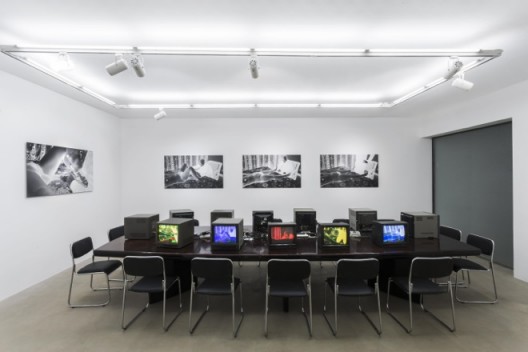
Ju Anqi: Restricted:Gaze, 2016, Three Channel Color Video, Silent, 17´18“, installation shot雎安奇,《R级: 观癖》,2016,三频彩色视频,17´18“,展览现场
Those are just a few of the thoughts that storm in upon being confronted yet again with an exhibition by Ju Anqi, the prolific filmmaker and artist. No, actually I am thinking of two shows. Already over a year ago a very challenging exhibition was presented at Beijing´s DeSarthe Gallery. “Restricted:Gaze” comprised of 12 (sic!) monitors distributed around a large conference table surrounded by an equal number of chairs, inviting the visitor engage in an one-to-one encounter with the artwork, similar to the subject matter of the one video playing out on all the screens. What you see is a naked woman lying on a duvet cover with flower patterns on top of a bed and an older man with, what in German would be called “Charakterkopf” – head with striking features, intently staring at the woman´s private parts in close range for an indiscernible duration, with the camera observing the whole scene. The only part of her you never see is her face.
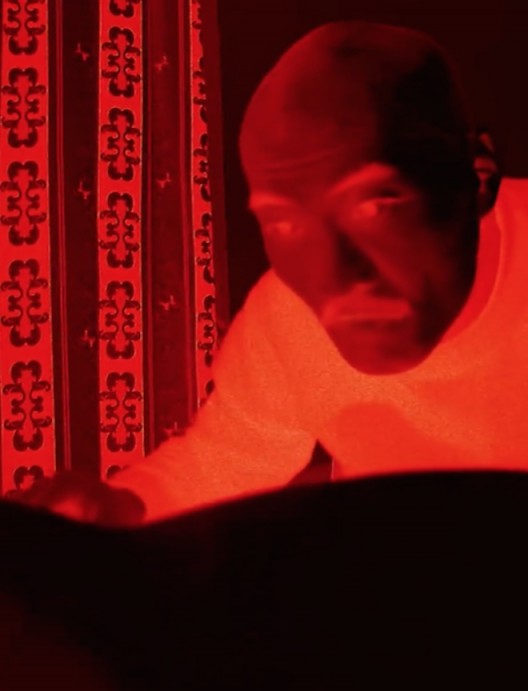
Ju Anqi: Restricted:Gaze, 2016, Three Channel Color Video, Silent, 17´18“, screenshot
雎安奇,《R级: 观癖》,2016,三频彩色视频,17´18“,视频截图
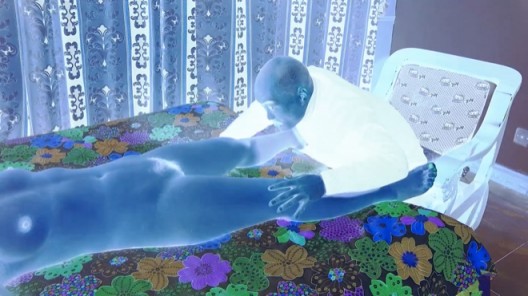
Ju Anqi: Restricted:Gaze, 2016, Three Channel Color Video, Silent, 17´18“, screenshot
雎安奇,《R级: 观癖》,2016,三频彩色视频,17´18“,视频截图
Shocking! – If this show would have taken place in NY … even before #me too, the artist would have been chased out of town by an angry mob. Not so in Beijing. During the opening quite a big crowd amongst which were many young, strong and self-respecting women, paid curious attention to the artwork and what was going on in the video. The intense gaze of the middle-aged man in the video, the artist Dai Chenlian, reveals no sense of sexual excitement, or even particular curiosity. He however the action is not only limited to viewing only, at times he reaches forward to spread the woman´s thighs so as to take better look. If anything the gaze appears to be almost surgical with cold and technical interest. The only buffer that prevents the whole scene to slip into obscenity is the artist´s decision to convert the footage into b&w negative with tints of the three primary colors plus green.
Does this objectify the woman, reducing her to flesh?! – Probably. But what is the artist´s intention and why is the audience so almost indifferent?! … But let´s take a reverse approach and talk about what the artist Ju Anqi was NOT aware of.
To any Westerner half-way interested in art and culture, the images of “Restricted:Gaze” would bear a striking semblance of two, three seminal pictures for culture in the West. Firstly the set-up of Sigmund Freud´s office – the floral bed cover in Ju Anqi´s video resembles the carpet on Freud´s couch and the curtain becomes the carpet on the wall. In Freud´s study room, his patients would lay down on the couch, while he would be seated at the head end to listen to their stories. This methodology to treat mental ailments became to be known as the “talking cure” in which patients would share (hurtful) experiences and traumas from early childhood to present occurrences. The basic idea, to put it in the simplest terms, was to identify and unlock repressed feelings that are at the root of the psychological symptoms that his patients were suffering from. Working through those feelings, so the theory, would ultimately liberate the patient and healing would set in. And as it were – in Freud´s view, at the core of many such afflictions was a culture of repressed sexuality of the late 19th century bourgeoisie. This idea should prove revolutionary and paved the way for all sorts of discourses of feminism, gender studies, alterity politics, etc.. Without psychoanalysis, there would never have been the sexual revolution and the generation of 68.
The second image is of course Courbet´s “L´origine du monde” (the beginning of the world). Supposedly commissioned from the artist by Halil Şerif Paşa, an Ottoman diplomat, in 1866. It took 122 years before the painting could be presented to the public in the Brooklyn Museum, NY in 1988, still causing a stir. Bought in 1955 by the pre-eminent psychoanalyst and philosopher Jacques Lacan, it was hidden behind a painting of his brother-in-law the surrealist painter André Masson. It is very likely to have influenced also Marcel Duchamp´s masterpiece in “Étant donnés” at the Philadelphia Museum of Art. The painting only resurfaced in public after Lacan´s death in 1981. The origin of the world – a deeply multi-coded title for an explicit painting, not only showing in anatomical detail a female vulva, the channel through which (almost) all of us have been born, but also and more potently alluding to sexual desire, as represented here yet again by the male gaze onto the female organ, which ultimately would lead to sexual unity, an ecstatic and ultimately de-limiting experience of the coitus, as the beginning (and end) of all worlds.
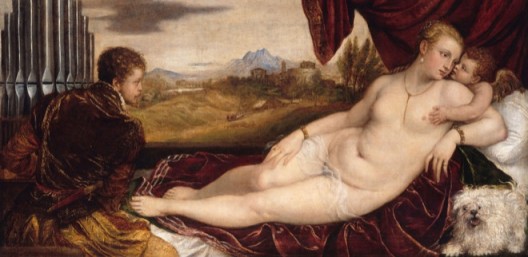
Titian: Venus with the organ player, 1550–1552 © Staatliche Museen zu Berlin, Gemäldegalerie / Jörg P. Anders
提香,《维纳斯和管风琴演奏家》,1550–1552,© Staatliche Museen zu Berlin, Gemäldegalerie / Jörg P. Anders
The third image is Titian´s “Venus and the organ player” (pun included already…) from 1550-52, depicting an organ player – one hand still on his phallic instrument – staring over his right shoulder with his gaze measuring the space between him and … and the goddess Venus, rendered as an opulent and extremely minimally veiled woman. Her gaze turned inward, she is listening to what a putto whispers to her in a delicately tender embrace. But does he really see her?! – His monocular stare seems to shoot right past her (like do the bachelors in Duchamp´s “Large Glass”). Upon closer observation, Venus appears not to be in the same space with the organ player. It is almost as if she is sailing in on the read velvet curtain like a vision.
So there a different ways of saying it: a) the musician is playing his music with such intensity that he is capable of summoning the goddess and makes her appear to his audience. b) in the masturbatory act of playing the organ he phantasizes of her and thus projects her into an imaginary space for him to stare at. – In any case, the intensity of his monocular gaze (one eye does not see space, you need two for that…) seems to indicate that he is not close to “woman”, he isn´t even far. He is just not there. His demeanor is that of desire or even lust and lacks all intimacy. The fact also that his eyes do not come to rest on her, exacerbates the situation almost to despair. In Titian´s painting, the only successful visual connection is to the little dog, which seems to look directly at us, the audience, reminding us, that we too are domesticated animals.
Ju Anqi´s video work in a strange way conflates all these three different images and their underlying visual regimes and adds the element of time. The performative character of the work profoundly changes the experience of both the performers and the audience … and of course we have all witnessed this before, if you do one thing and that thing only for a long time, it loses emotional content and becomes emptied out. This is what Dai Chenlian reported of his experience of staring intently for more than an hour – all thoughts of intimacy dissipated. It is like in meditation, a slow distancing of the subject of the world and without trying to read too much into this now, Ju Anqi is a practicing Buddhist.
This might be one explanation why the exhibition at the DeSarthe Gallery did not cause an outcry. The work itself did not become pornographic or sexual. In fact sort of the opposite happened. The images did not appeal to the audience´s sense of desire and incite them. However also another element had to contribute the effects of the exhibition. As stated before, in NY the same show would inevitably have created a shit storm, because the issue is so short-fused that the fact of a man, staring at a woman´s female parts, would have blinded everybody to the work´s “deeper” meaning. So it takes a different cultural environment in which this work can communicate differently and more subtly. After asking around it became astonishingly clear that most women present there, didn´t put themselves into the position of the female model. They simply refused to identify with the objectified woman. Only after pushing them to think about being themselves subjected to this, they felt “uneasiness”, as one young lady said.
In essence, China has not been afflicted by the “virus of psychoanalysis”, as Sigmund Freud famously said to C.G. Jung on their ocean liner approaching New York: “We are bringing them the virus, and they don´t even know it.” Nor has China had any experience with the culture wars of identity politics that drove America apart again. In the quest for justice and equality, people in America lost their freedom.
What about that in China, one might ask?! – and yes, what about that? After a long time since its humiliation at the hands of much smaller Western countries, China is developing strong muscles again and stepping up on the world stage. Most Chinese are absolutely happy about the newly created wealth and enjoy the prospects of a still developing country.
Ju Anqi´s approach to that is to investigate one of the most difficult subject matters to address these days: masculinity. His is the inaugural show of an alternative art space called “de Art Center”, run by the very prolific Mr Xia Yanguo, entitled “1.5~2℃ lower than Body Temperature“. The major „piece“ is a projected video in the rear of the gallery covering the entire wall showing wrinkled skin – a male scrotum. The hypothesis is that men carry their testicles outside their body cavities, because sperm, in order to develop strong and agile needs an environment 1.5~2℃ lower than body temperature. The control of that is inadvertently executed by two mechanisms, the cremaster muscle made famous by the artist Matthew Barney and the tunica dartos, a layer of flat muscle tissue inside the scrotum that can contract and relax not only to change in temperature but also sexual stimulation. The scrotum is biologically homologous to the labia majora in females, the outer lips of the vagina. In Ju Anqi´s video one sees the tunica dartos, wearing make-up like a character in a Chinese opera, contract and relax to the tune of a Mahler symphony. The slow-motion effect of seeing the scrotum contract will instill a very strong sensation in the male audience of this video, stemming from everybody´s very private experience.
Shot a very close range again, the video can be seen as complementary to “Restricted:Gaze”, with the difference that the audience this time does get an unfiltered view of (a part of) the male sexual organ and not, as in the case of “Restricted:Gaze” by proxy, watching someone watching it. Again, the sexual connotations and even the bodily sensations that watching the footage might instill in the male audience are somehow abstracted, sublimated to another level, so as to discuss on a much more general level masculinity, which is anathema in any country of the world right now. But if one wishes to go down the path of associations triggered by Ju Anqi – the gonads, which are contained inside the scrotum are of course the ultimate organs of potency – maybe even of creative powers.
This video projection is juxtaposed by a video installation comprised of a stack of three monitors half way inside a semi-circle of five globes of the earth lit from within, creating a configuration strangely reminiscent of the flag of a major Asian country. The three monitors, from the top down show three very distinct video loops. The top one shows an eye of Asian shape staring intently into the camera and therefore, at the audience. “I am watching you”, it seems to say. The monitor in the middle shows the center of our planetary system, the sun, and the bottom monitor shows the very muscular upper body of a male body builder.
The work is a meditation on power and masculinity and a symphony of images. As a filmmaker, Ju Anqi is well versed in the use of the ultimate desire-machines, which are camera and projector. The monocular gaze, as we learned before, is what connects us to what we desire and at the same time separates us too. What we see, that we don´t have. The camera is that same stare which has become a machine. The camera is also always between us and the object in our focus. And similarly, the camera is a distance weapon. This is why we “shoot” images. In order to aim and shoot a gun, we need to close one eye. The camera also reduces our binocular vision to one lens. As an artist, Ju Anqi´s work deconstructs the power of the monocular gaze executed through the lens of the camera and reveals the camera´s inextricable entanglement and unquestioned collusion with power in the broadest sense. In sexuality as well as politics, the camera is the most potent tool to establish, assert and exert power.
It has become a habit now between the artist Ju Anqi and the author of this text. Every time we meet, we take a photo of ourselves, with one eye closed. Asian wisdom would rather have it we close both eyes and open our third eye. What are we doing wrong?!
